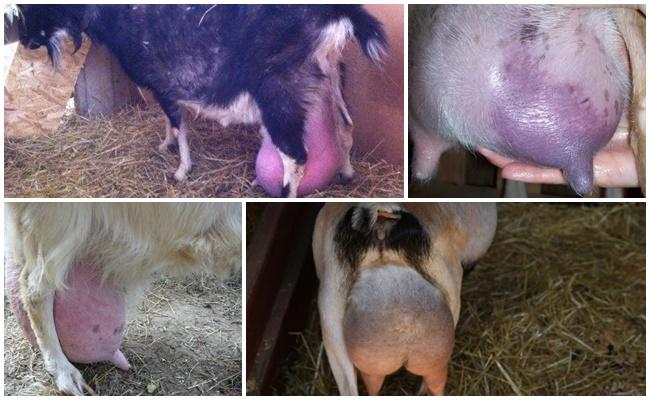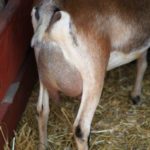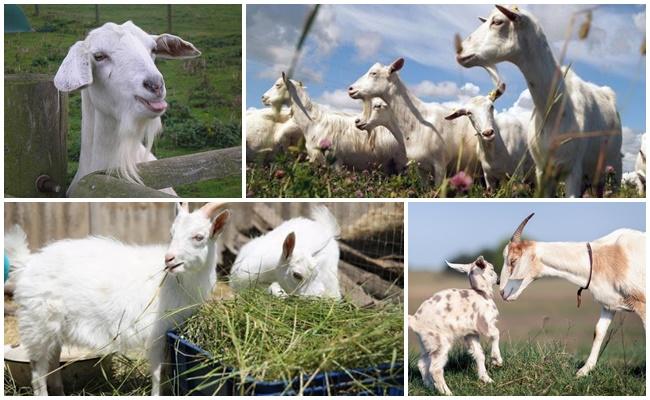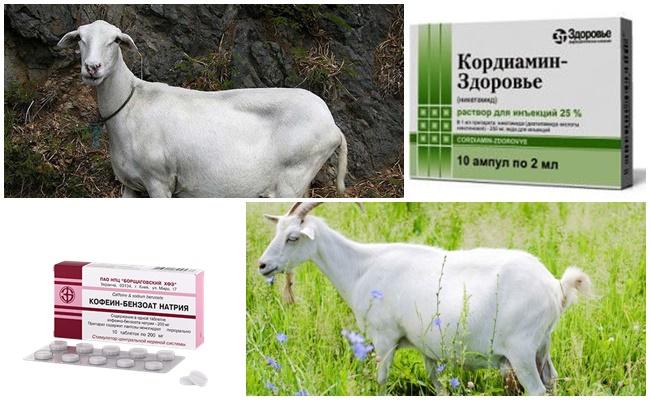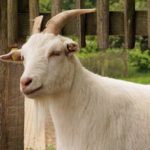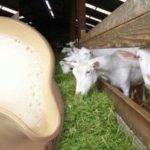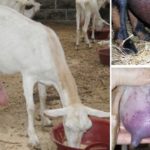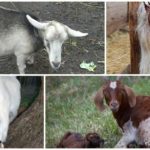If a goat doesn’t eat or drink anything after lambing, it means she’s sick. It is necessary to find out the cause of the disease and begin treatment. Typically, problems with appetite occur if animals have a fever due to an infectious infection or are given rough and poor-quality food. After lambing, the goat will need some time to recover. During this period, animals need to be fed with high-quality feed, and in case of infection, antibiotics can be injected.
Causes and treatments
After lambing, the goat becomes very weak, because during childbirth she loses a lot of strength. It is advisable to have a person present during this physiological process. As soon as the kids are born, even before the placenta comes out (it comes out 1-1.5 hours after the offspring appear), the goat needs to be milked. There is not a minute to lose, otherwise the female may have problems with her udder due to the accumulated milk.
Mastitis
Straightaway After lambing, a goat may develop false mastitis. The animal's udder swells, the nipples become rough, and the outflow of milk becomes difficult. The goat does not eat hay well, refuses its favorite treats, and does not want to drink. This is not a disease, but a typical udder swelling. The animal's condition can be improved with the help of diuretics or herbs (chamomile, nettle, parsley, black currant leaves), dill (from the seed) sweetened decoction and regular expression of milk. In this case, you cannot massage the udder, otherwise the goat will develop real mastitis.
If the problem is ignored, the disease will quickly develop. Mastitis is a disease of the udder in which it becomes hard and lumps appear inside. The reason is that the ducts through which milk flows become clogged. If a goat is kept on dirty bedding, then due to weakened immunity after giving birth, mastitis can be accompanied by an infection. In this case, you will need treatment with antibiotics (Bicillin, Streptomycin, Mastiet Forte).
The first step when mastitis is detected is to lubricate the udder with novocaine ointment, and after pain relief, do a light massage. Ichthyol ointment provides a good anti-inflammatory effect. It is advisable not to feed the goat before giving birth with foods that stimulate increased milk production.
Endometritis
After lambing with complications (injuries, retained placenta) due to bacteria entering the uterus a goat may develop endometritis. This is an inflammatory process in which the animal’s temperature rises slightly and a cloudy gray exudate mixed with blood and an unpleasant odor is released from the genitals. The disease develops 2-5 days after birth. The animal refuses to eat and drink, it loses milk, it often gets into a position to urinate, and bends its back. A few days later, it becomes noticeable how the goat with endometritis has lost weight.
The disease can be provoked by dirt and high humidity in the barn. Proper feeding of the animal, constant walks in the fresh air, and mandatory drinking plenty of fluids help reduce the likelihood of endometritis. The room where the birth will take place must be clean, dry and warm. Before lambing, the goat should be given carrots, spruce branches, pharmaceutical vitamins and minerals, and immunostimulants.
An animal with endometritis must be treated. The uterus is washed with a warm solution of potassium permanganate or furatsilin. For rinsing, you can use 3% Ichithiol. Tricillin powder or Septimethrin capsules are injected intrauterinely. In severe cases (with sepsis), antibiotic injections, camphor serum according to Kadykov, as well as sulfonamide and nitrofuran drugs are prescribed. To improve uterine contractions, Oxytocin or Pituitrin is given.
Atony of the forestomach
After giving birth, a weakened female may experience digestive problems. The problem is aggravated by food that is poor in vitamins but rich in fiber (straw, pilaf), as well as feeding with grain mixtures. In sick goats, appetite decreases and the movement of food through the stomach slows down.Animals may lose belching.
If goats are given a lot of water and legumes, bloating may occur due to difficulty passing gas.
Hellebore tincture helps improve gastric motility. For hypotension, a 5% sodium chloride solution is prescribed. Motor function is improved by infusion of wormwood or gentian root, cabbage brine, and a solution of pharmaceutical lactic acid. A weak solution of acetic acid (20 ml of 9% vinegar per 2 liters of water) with sugar (30 g) helps improve fermentation in the stomach. If the abdomen is bloated, you need to lift the goat's head and stick out its tongue with your hand until a burp appears, and then insert a rubber hose into the esophagus to release gases.
Ketosis
After lambing in winter, goats can develop ketosis. This disease is a consequence of improper feeding. Ketosis occurs if there is an excess of grain mixtures and legume hay (alfalfa) in the diet. The disease is diagnosed primarily by the acetone odor of urine.
The disease can be prevented and even cured if you give the female sweetened water, as well as sweet food (carrots, pumpkin, Jerusalem artichoke, sugar beets).
Coniferous and spruce branches, cereal hay, and high-quality silage help prevent ketosis. Catozal is used to treat this disease. If nothing is done, the disease will become chronic and can lead to the death of the animal.
Milk fever
After giving birth, a goat sometimes experiences a decrease in vital processes. The animal may be in a depressed or, conversely, excited state. In sick females, appetite disappears, trembling or twitching of the muscles of the body and limbs is noticeable. The body temperature drops, the amount of milk decreases, and the stomach swells.The sick animal is given sugar-sweetened water to drink, a 10% glucose solution and a 10% calcium chloride solution, as well as “Cordiamin” or “Caffeine-sodium benzoate” are prescribed intravenously. Females who have given birth should receive vitamin D and calcium-rich feed (legumes).
Prevention measures
Goats get sick after lambing due to improper feeding or being kept in unfavorable conditions. Females are usually covered in the fall. Pregnancy (5 months) occurs in winter and early spring. During this period, the percentage of vitamins and nutrients in prepared feed (in hay, vegetables) sharply decreases.
During pregnancy, females should be given spruce branches, finely chopped carrots, Jerusalem artichoke, pumpkin, pharmaceutical vitamins, minerals, and premixes. Goats should not overeat or starve. Pregnant animals should be kept in a clean, dry and warm environment.
Starting from the 3rd month of pregnancy, the goat needs to be started, that is, stopped milking. During this period, all useful substances should go to the development of the fetus, and not into milk. It is advisable to feed a pregnant goat with sweetened water (30 g per 2-3 liters of water). Grain mixtures are given to animals in minimal quantities. Instead of wheat, you can feed females wheat bran.
Recommendations
Refusal to eat and lack of appetite is a symptom of some disease. True, immediately after lambing, the goat may not eat well, since during this period she experiences pain after eating. After a few hours, the female’s vital functions should return to normal.
The lambing goat needs to be given sweetened water to drink and the milk to be expressed. Cabbage brine or mash (20 g of vodka, 2 liters of water, 30 g of sugar, 10 g of yeast) improves appetite. To improve belching, brew hay with boiling water and give the goat a warm infusion.Feeding a small amount of oats helps restore strength. Sometimes goat refuses to eat because of worms. After giving birth, it is advisable to give the female antiparasitic drugs.

